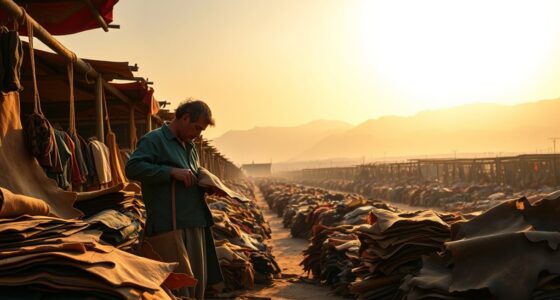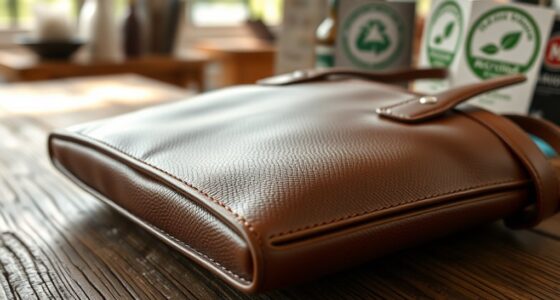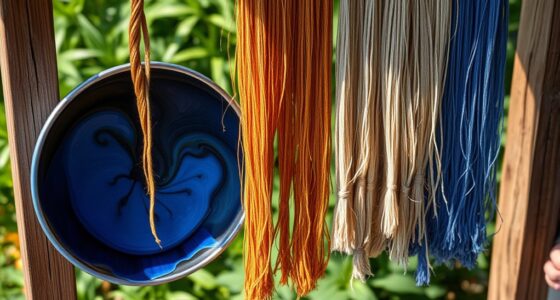Faux leather may seem eco-friendly, but behind the scenes, its production involves chemical dyes that pollute water and energy-intensive processes that emit carbon. It relies on non-renewable resources like petroleum and creates waste difficult to recycle. However, many brands are now adopting sustainable alternatives like plant-based leathers made from mushrooms or pineapples, reducing environmental harm. To see how these innovations are transforming the industry, continue exploring the efforts behind greener faux leather solutions.
Key Takeaways
- Faux leather production involves energy-intensive processes and synthetic dyes that release toxic runoff, harming ecosystems.
- Chemical dyes and synthetic fibers used in faux leather contaminate water sources through runoff, posing environmental and health risks.
- Manufacturing faux leather relies heavily on non-renewable resources like petroleum, increasing carbon footprint and resource depletion.
- Brands are developing biodegradable and plant-based alternatives, reducing chemical use, water consumption, and overall environmental impact.
- Industry leaders are adopting sustainable practices, ethical sourcing, and innovative materials to minimize waste and lower carbon emissions.
The Manufacturing Process and Its Environmental Impact

The manufacturing process of faux leather often seems eco-friendly at first glance, but in reality, it has significant environmental costs. One major issue is synthetic dyeing, which involves using chemical dyes that often release toxic runoff into nearby ecosystems. These dyes are not biodegradable and persist in the environment, contributing to pollution. Additionally, the production of faux leather relies on energy-intensive processes, requiring large amounts of electricity and heat. These processes often depend on fossil fuels, increasing carbon emissions and climate impact. While faux leather avoids some animal welfare concerns, its manufacturing still leaves a heavy environmental footprint. Understanding these hidden costs helps you see that even seemingly sustainable alternatives can come with hidden environmental consequences. Moreover, the resources and tools used in production, such as synthetic polymers, are derived from non-renewable sources, further exacerbating environmental degradation. The manufacturing techniques involved also generate considerable waste and chemical byproducts that pose challenges for safe disposal and recycling. Additionally, the production of synthetic polymers often involves the use of petroleum-based raw materials, which are finite and contribute to resource depletion. The environmental impact of these processes continues to be a concern for sustainability efforts worldwide. Recognizing the full lifecycle of faux leather products can help consumers make more informed choices about their environmental footprint.
Chemical Use and Water Pollution Concerns

Although faux leather may seem like a more sustainable choice, its production involves significant chemical use that harms water sources. During manufacturing, toxic dyes are often used to achieve vibrant colors, but these dyes can leach into nearby water bodies through chemical runoff. This runoff contaminates rivers and streams, affecting aquatic life and communities relying on these water sources. The chemicals involved, including heavy metals and hazardous solvents, don’t just stay in the production process—they pollute the environment long after. Many factories lack proper waste management, allowing these toxins to seep into the water system. As a result, water pollution from chemical runoff and toxic dyes poses serious environmental and health risks, highlighting the hidden costs behind faux leather’s seemingly eco-friendly image.
Resource Consumption in Faux Leather Production
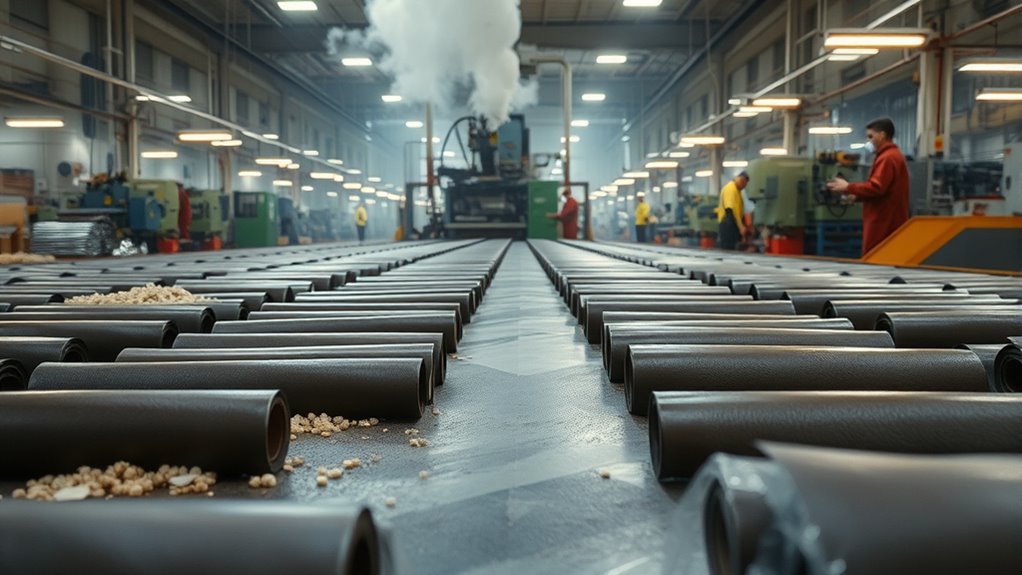
Producing faux leather consumes significant amounts of resources, often surpassing the environmental footprint of genuine leather. It relies heavily on synthetic fibers like polyurethane and PVC, which require substantial raw materials and energy to produce. The manufacturing process demands high energy use, especially during the creation of these fibers and the layering of materials. This energy consumption contributes to greenhouse gas emissions, further impacting the environment. Additionally, synthetic fibers are derived from petrochemicals, making their production resource-intensive and dependent on fossil fuels. The extensive resource demands mean that, despite being a vegan alternative, faux leather can have a considerable environmental cost. Resource-intensive production efforts are underway to develop more sustainable manufacturing methods, aiming to reduce the environmental impact of faux leather. These innovations focus on reducing fossil fuel dependence and improving the recyclability of synthetic materials.
Innovative Materials and Sustainable Alternatives

Innovative materials are emerging as promising solutions to reduce the environmental impact of faux leather. These sustainable alternatives focus on synthetic sustainability, using plant-based or bio-derived components to create durable, eco-friendly options. For instance, mushroom leather and pineapple fiber are gaining popularity because they require less water and energy, and they avoid harmful chemicals. Ethical sourcing also plays a critical role, ensuring raw materials are harvested responsibly, supporting fair labor practices, and minimizing ecological disruption. By shifting toward these innovative materials, brands can substantially lower their carbon footprint and reduce reliance on traditional synthetic plastics. As you explore sustainable fashion, look for products made from these new materials, which combine environmental benefits with ethical sourcing, paving the way for a greener, more responsible industry.
Brands Leading the Charge Toward Greener Faux Leather
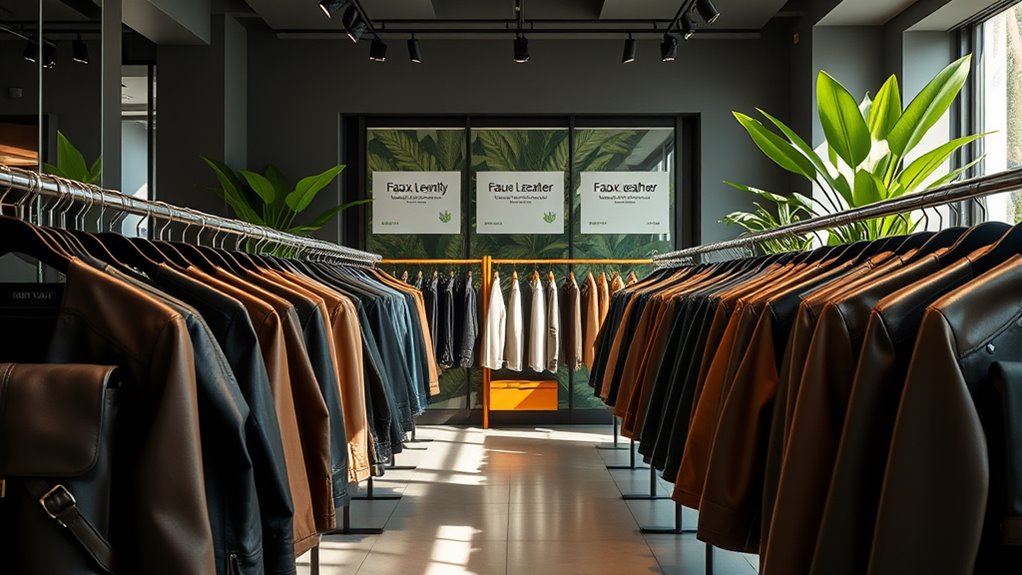
Many brands are now taking bold steps to lead the shift toward greener faux leather options. They’re addressing biodegradability challenges by developing materials that break down safely, reducing environmental impact. These companies prioritize ethical sourcing practices, ensuring that their materials come from responsible sources that respect both people and the planet. Their efforts inspire confidence and hope for a more sustainable future. Incorporating active listening strategies into their corporate responsibility initiatives helps foster trust and loyalty among consumers. Additionally, focusing on sustainable manufacturing processes minimizes waste and lowers carbon footprints throughout production. Embracing innovative material development techniques enables brands to create environmentally friendly products without compromising quality. Understanding the environmental impact of materials is essential for driving meaningful change in the industry.
Frequently Asked Questions
How Does Faux Leather Compare to Genuine Leather in Environmental Impact?
When comparing faux leather to genuine leather, you find that faux leather often has a lower biodegradability, meaning it doesn’t break down easily in the environment. Water usage analysis shows faux leather typically requires less water to produce than genuine leather, making it a more eco-friendly option overall. However, consider the full lifecycle impacts, as some faux leathers involve plastics that can be problematic for sustainability.
Are There Certifications to Verify Sustainable Faux Leather Products?
They say, “trust but verify,” and that’s true for sustainable faux leather. Yes, there are certification standards and eco label programs that validate the sustainability of faux leather products. These certifications ensure brands meet eco-friendly criteria, helping you make informed choices. Look for labels like GOTS or OEKO-TEX, which signal adherence to strict environmental and social standards, so you can choose products that align with your eco-conscious values.
What Are the Long-Term Environmental Benefits of Switching to Faux Leather?
Switching to faux leather offers long-term environmental benefits by reducing your ecological footprint, as it avoids animal farming’s high resource use. While biodegradability challenges exist since some faux leathers are synthetic, newer plant-based options are improving. By choosing sustainable faux leather, you help lower pollution and conserve resources, making a positive impact on the planet. Your choices can support innovations that address biodegradability challenges and promote greener alternatives.
How Does the Durability of Eco-Friendly Faux Leather Affect Its Environmental Footprint?
You’ll find that eco-friendly faux leather’s durability reduces the need for frequent replacements, lowering overall environmental impact. However, biodegradability concerns mean it may persist longer in landfills, and manufacturing energy consumption can be higher compared to natural materials. This durability can be beneficial, but it’s essential to weigh these factors to truly understand its environmental footprint and how it compares to traditional leather.
Can Recycled Materials Be Used Effectively in Faux Leather Manufacturing?
Did you know that over 80% of textiles, including faux leather, can be recycled? Recycling innovation is making it possible to use recycled materials effectively in faux leather manufacturing, markedly reducing waste. By focusing on material efficiency, brands can create durable, eco-friendly products while minimizing environmental impact. Using recycled content not only conserves resources but also promotes sustainable practices, making faux leather a smarter choice for environmentally conscious consumers like you.
Conclusion
As you explore the world of faux leather, you’ll find that behind its stylish appeal lies hidden environmental costs. Luckily, brands are starting to innovate, making greener choices that align with your values. It’s a coincidence that progress is happening just as awareness grows, proving that sustainable fashion isn’t just a dream but a real possibility. By choosing responsibly, you become part of the movement toward a cleaner, more mindful future—where style and sustainability go hand in hand.


